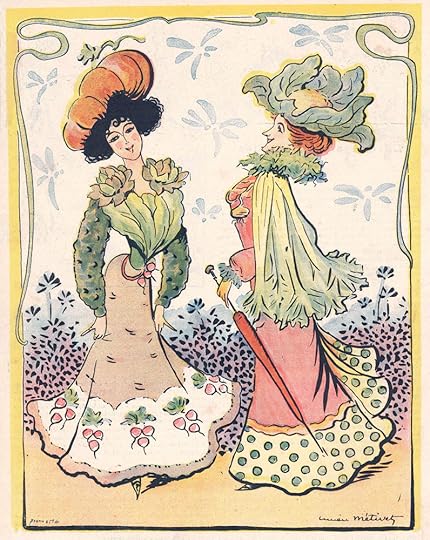La Couture Comique

Lucien Métivet’s name may not be familiar to many contemporary readers or art aficionada, and placed alongside that of his friend and fellow art student Henri de Toulouse-Lautrec it may seem, by comparison, thoroughly obscure. A century ago, however, Métivet was a hugely popular belle epoque artist, celebrated not so much for his paintings as for his posters, book and magazine illustrations, advertising art, and—especially—his humorous drawings. He embodied, in the 1890s and after, an idea that the world has only now begun to embrace: that a cartoonist and fine artist can be one and the same.
His 1893 poster portraying chanteuse Eugénie Buffet as a woman of the cold streets not only advertised her performances at the club Ambassadeurs; it immortalized her stage persona and made Métivet’s name at the age of thirty. It remains as much a part of the visual legacy of the era as Toulouse-Lautrec’s posters of Buffet’s mentor Aristide Bruant. But Métivet’s stock in trade for the decades that followed was drawing, swiftly and prolifically, for publication—whether supplying covers and cartoons for Le Rire (Laughter), the most popular humor journal in Paris, or dozens of illustrations for an edition of Maupassant or Balzac, or for a lesbian-themed erotic novel (or two) by Pierre Louÿs, or for the first two adventure-filled volumes of Paul d’Ivoi’s Voyages Excentriques, a hugely successful (and conspicuously deliberate) competitor to Jules Verne’s Les Voyages Extraordinaires.
Quantity and artistic quality, however, rarely go hand in hand, especially under deadline, and an undiscriminating catch-all collection of L. M.’s work is liable to make a poor impression, cluttered as it is with examples of the slapdash and the merely adequate. That the appreciation of a prolific artist requires selectivity is no surprise; the surprise, instead, is the insouciance of the exceptions, the fact that among drawings printed as amusing diversions a century ago there are those that still charm, still resurface with a wink and a smile to inspire a reciprocal smile across a divide of so many generations. The survival of the sunny and comic, as if blithely stepping over world wars, cultural upheavals, and time itself, is always a kind of miracle.
And now it is spring again, a time when ladies, and at least a few gentlemen, think of fashion. Métivet’s Modes Potagères (Vegetable Fashion), a full-page color illustration from the April 6, 1901, issue of Le Rire included a brief text as caption, which encourages us to note, and savor, such features as the lettuce bodice, pickle sleeves, and artichoke ruffle on the outfit of the dark-haired beauty in the pumpkin toque; and the beetroot princess dress with its green-pea flowerbed and cardoon collar with curly-endive neck ruff on the elegant lady of the cauliflower hat and carrot umbrella. With its precisely enumerated whimsicality, cheerful colors, and the evident and so-human pride and pleasure in the faces and postures of the models, this is an image perpetually floriferous. Read More »
The Paris Review's Blog
- The Paris Review's profile
- 305 followers



